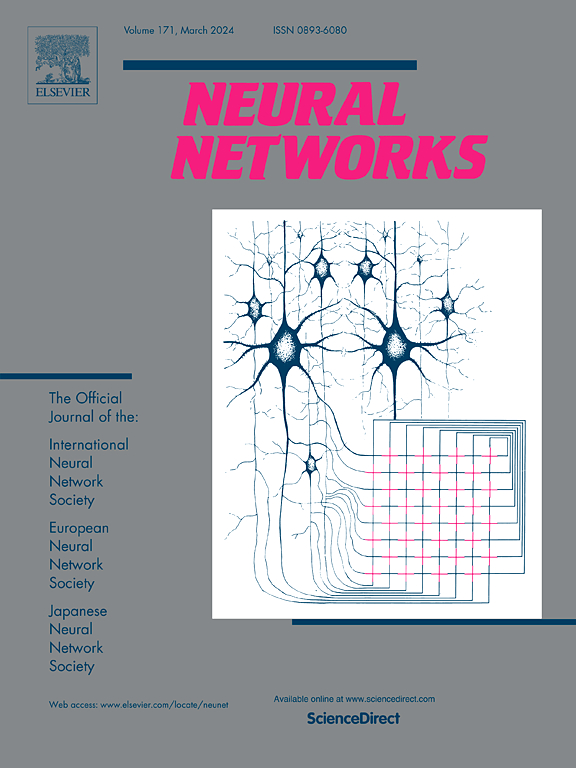An extrapolation-driven network architecture for physics-informed deep learning
IF 6.3
1区 计算机科学
Q1 COMPUTER SCIENCE, ARTIFICIAL INTELLIGENCE
引用次数: 0
Abstract
Current physics-informed neural network (PINN) implementations with sequential learning strategies often experience some weaknesses, such as the failure to reproduce the previous training results when using a single network, the difficulty to strictly ensure continuity and smoothness at the time interval nodes when using multiple networks, and the increase in complexity and computational overhead. To overcome these shortcomings, we first investigate the extrapolation capability of the PINN method for time-dependent PDEs. Taking advantage of this extrapolation property, we generalize the training result obtained in a specific time subinterval to larger intervals by adding a correction term to the network parameters of the subinterval. The correction term is determined by further training with the sample points in the added subinterval. Secondly, by designing an extrapolation control function with special characteristics and combining it with a correction term, we construct a new neural network architecture whose network parameters are coupled with the time variable, which we call the extrapolation-driven network architecture. Based on this architecture, using a single neural network, we can obtain the overall PINN solution of the whole domain with the following two characteristics: (1) it completely inherits the local solution of the interval obtained from the previous training, (2) at the interval node, it strictly maintains the continuity and smoothness that the true solution has. The extrapolation-driven network architecture allows us to divide a large time domain into multiple subintervals and solve the time-dependent PDEs one by one in a chronological order. This training scheme respects the causality principle and effectively overcomes the difficulties of the conventional PINN method in solving the evolution equation on a large time domain. Numerical experiments verify the performance of our method. The data and code accompanying this paper are available at https://github.com/wangyong1301108/E-DNN.
物理信息深度学习的外推驱动网络架构。
当前采用顺序学习策略的物理信息神经网络(PINN)实现往往存在一些弱点,例如使用单个网络时无法重现先前的训练结果,使用多个网络时难以严格保证时间间隔节点的连续性和平滑性,以及复杂性和计算开销的增加。为了克服这些缺点,我们首先研究了PINN方法对时变偏微分方程的外推能力。利用这种外推特性,我们通过在子区间的网络参数中加入校正项,将在特定时间子区间内得到的训练结果推广到更大的时间区间。修正项是通过对添加的子区间内的样本点进行进一步训练来确定的。其次,通过设计具有特殊特征的外推控制函数,并将其与修正项相结合,构造了一种网络参数与时间变量耦合的神经网络结构,称为外推驱动网络结构。基于该体系结构,利用单个神经网络,我们可以得到整个域的整体PINN解,该解具有以下两个特点:(1)它完全继承了之前训练得到的区间局部解;(2)在区间节点上,它严格保持了真解所具有的连续性和平滑性。外推驱动的网络架构允许我们将一个大的时域划分为多个子区间,并按时间顺序逐个求解与时间相关的偏微分方程。该训练方案尊重因果关系原理,有效克服了传统的PINN方法在大时间域上求解演化方程的困难。数值实验验证了该方法的有效性。本文附带的数据和代码可在https://github.com/wangyong1301108/E-DNN上获得。
本文章由计算机程序翻译,如有差异,请以英文原文为准。
求助全文
约1分钟内获得全文
求助全文
来源期刊

Neural Networks
工程技术-计算机:人工智能
CiteScore
13.90
自引率
7.70%
发文量
425
审稿时长
67 days
期刊介绍:
Neural Networks is a platform that aims to foster an international community of scholars and practitioners interested in neural networks, deep learning, and other approaches to artificial intelligence and machine learning. Our journal invites submissions covering various aspects of neural networks research, from computational neuroscience and cognitive modeling to mathematical analyses and engineering applications. By providing a forum for interdisciplinary discussions between biology and technology, we aim to encourage the development of biologically-inspired artificial intelligence.
 求助内容:
求助内容: 应助结果提醒方式:
应助结果提醒方式:


